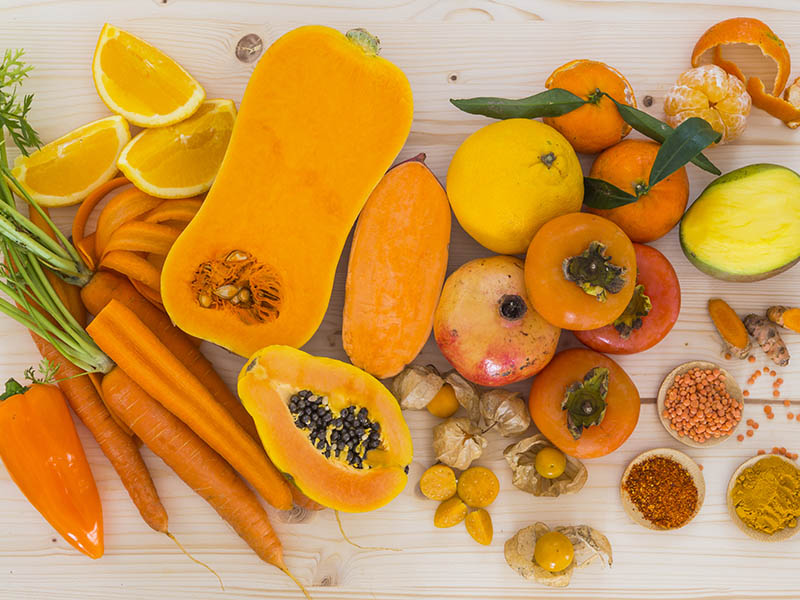
Orange fruits are your cup of tea, but there are only two to three names, you know. Are you bored of eating the same fruits day in and day out? No biggie! I am here to help you get out of this boresome cycle.
Reading this article, you will learn about dozens of orange fruits with detailed information about them. Specifically, you will gain their names, appearance, taste, and health benefits. Furthermore, you will also know which dishes fit with those types of orange fruits.
Sounds good? Let’s start with me right now!
A To N Orange Fruits With Miraculous Health Benefits
In the first half list, you will come across seven orange fruits with initials from A to N. Some may be well-known, and some may be strange. Can you guess any of them? Let’s check them out!
1. Apricots
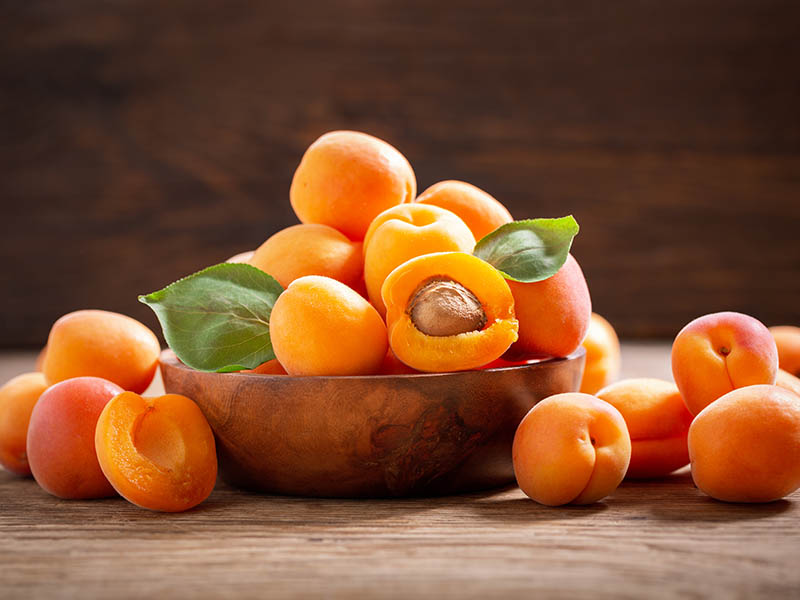
Apricots are yummy and juicy fruits that have the same family as peaches. That’s why this fruit’s appearance is similar to peaches but with a smaller size. When you taste a ripe apricot, you will feel a floral sweetness with a hint of tartness. On the contrary, the unripe one will be prominently tart.
Regarding its nutritional value, apricots have high fiber content, helping cure constipation and lower diarrhea conditions. In addition, consuming apricots will also help enhance your brain activities due to their rich mineral zinc.
Similar to peaches, you can eat apricots as a snack or use them for cooking and baking. With their floral sweetness, there are a bunch of dishes you can make from them. For instance, you can make smoothies, breakfast oatmeal, or even combine with the chicken to spice up the dish flavor.
2. Butternut Squash

Butternut squash is a long-lived fruit you can keep in your pantry. It has a cylindrical shape attached to a bulbous end, whereas the fruit skin is thin, firm, and beige-colored. Underneath the surface, the flesh is vibrant orange and contains many seeds at the bottom center.
Like other squash, butternut squash is low in calories and contains loads of fiber, making it a perfect food for weight loss diets and digestive support. In addition, butternut squash is also rich in vitamins and minerals, such as zinc and vitamin C, helping promote your bone system and immunity.
Although butternut squash looks hard at first sight, it will become creamy after cooking. Therefore, many people prefer to use it for cooking soup to keep warm in winter. Indeed, it is one of the first foods for toddlers.
Find butternut squash interesting? You should try these three recipes!
3. Cantaloupe
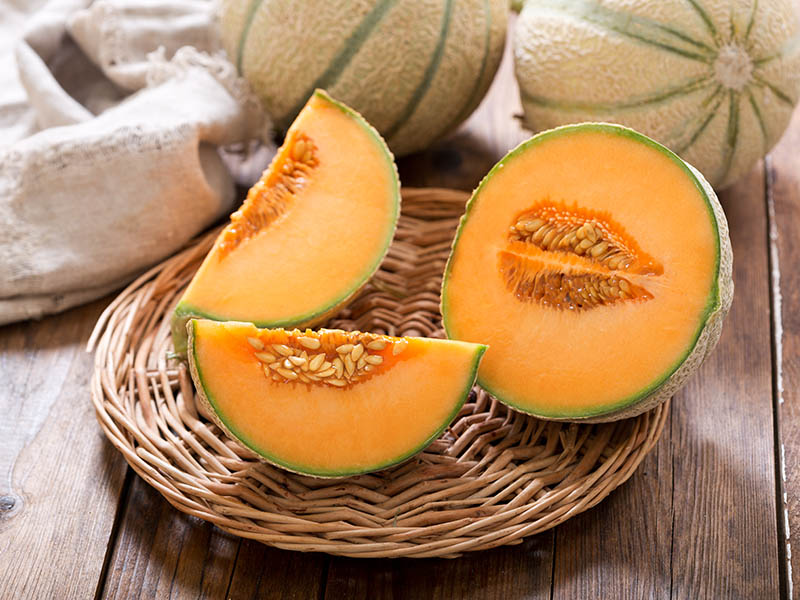
Cantaloupe boasts a complex flavor. When ripe, cantaloupe is sweet, juicy, and flowery fragrant with a soft and tender texture, whereas it will be flavorless and dry with a firm texture when unripe. Thus, you should wait until it is ripe to enjoy this fruit to the fullest.
Regarding the fruit, there are plenty of health benefits. In particular, cantaloupe is high in beta-carotene, a pigment converting to vitamin A and maintaining your eye health. Also, the fruit contains folate and vitamin C, helping enhance your immunity and prevent cancers.
Enjoy this fruit fresh, or make various cantaloupe-based dishes as your daily fruit treat. And you can easily check if the fruit is ripe since the rind will tell you. When ripe, the skin underneath its pattern will turn creamy beige with a hint of floral aroma.
4. Kumquats
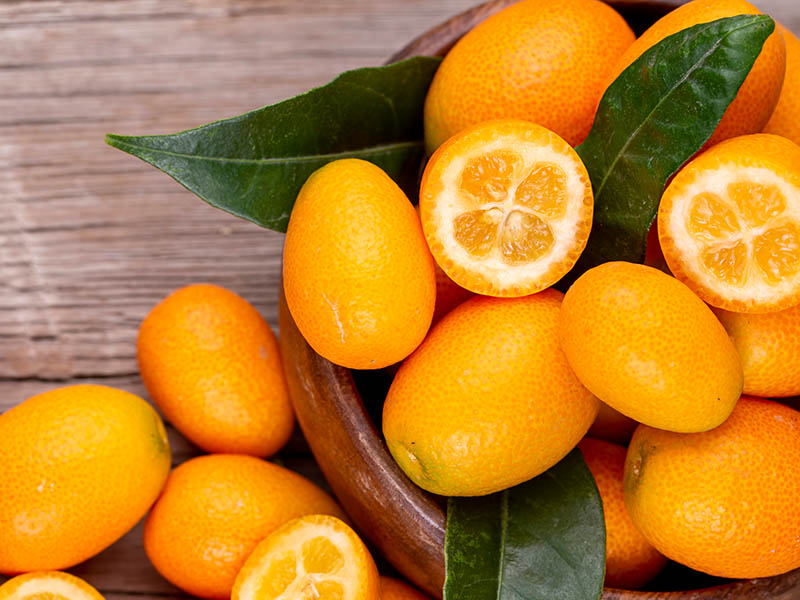
Kumquats are a fruit native to South Asia. The fruit has a rounded oval and oblong shape with a small size, about an olive. Inside, the flesh has three to five segments and a few seeds in the center. Compared to other famous varieties of citrus fruits, kumquats lack juice in their flesh.
However, it has a distinctive taste. While the flesh is sour with a tangy note, its peel is slightly sweet, creating the tasty flavor you would enjoy eating more. Thus, to eat kumquats the right way, you should roll the fruit a few times to release the sweetness and aroma of the peel into its flesh.
Eating kumquats will bring numerous benefits, thanks to their richness in nutrients. Kumquats contain high vitamin A and C content, helping boost your immunity. In particular, Asians smash them with ginger and honey and make them into tea to cure the flu and colds.
Let’s discover more things about kumquats here!
5. Mandarins
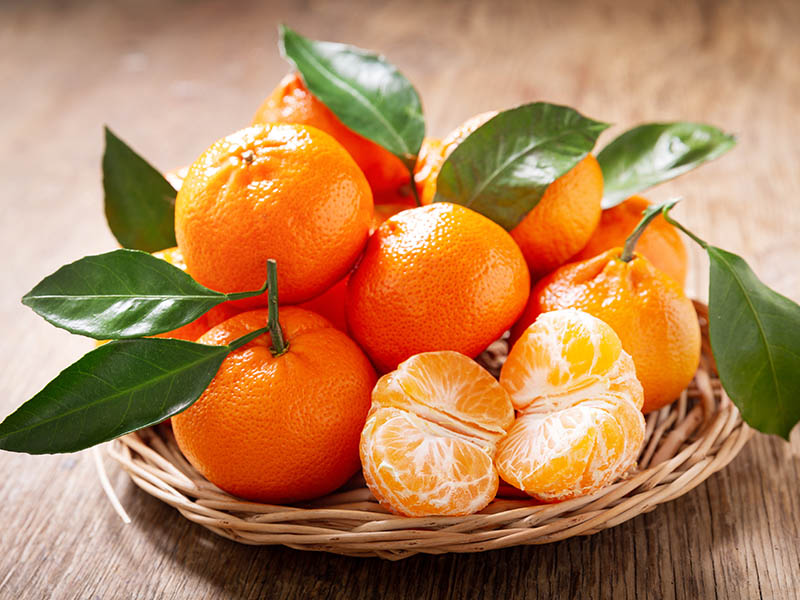
Compared to oranges, mandarins have a sweeter taste and looser thin skin that are easier to peel. This fruit also has a characteristic aroma crossing between floral and vanilla odor. All things combined will make you fall in love with the fruits at first sight.
Indeed, people make full use of the mandarins’ parts. You can peel off their segments for your salad bowl and baking cakes or as a garnish for your main dishes. Or, you can squeeze their juice for salad dressings. Moreover, utilizing their peels is also a way to spice up your dishes.
Besides its flavor, people also use mandarins because of their health benefits. They offer a good source of vitamin C and fiber, helping strengthen your overall health and lower your digestive problems. Also, the vitamin A in mandarins will improve your vision health.
6. Mangoes
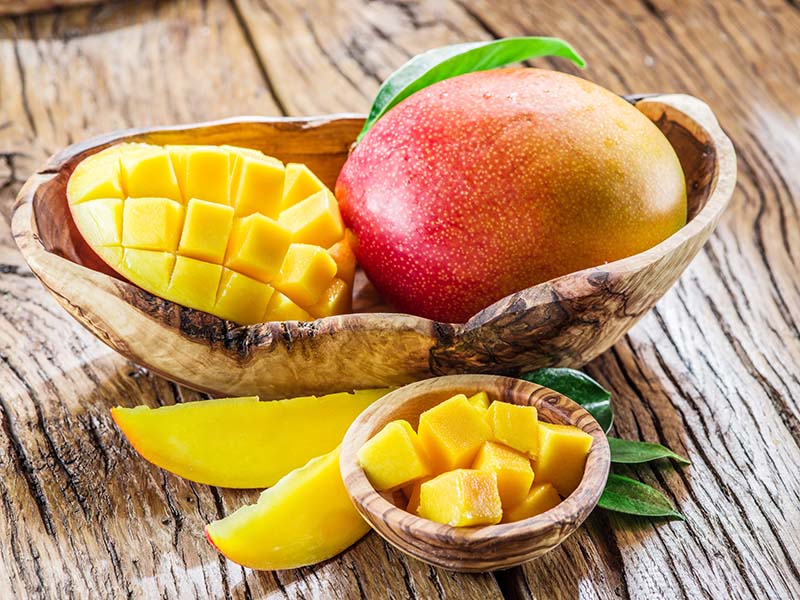
Mangoes are tropical trees having an extremely long life span, bearing fruit up to 300 years. Moreover, mangoes are also a symbol of love in India. If you want to show love to your Indian friends, you should give them a basket of mangoes.
Famous for their floral sweetness, this species of tropical fruit also have many health benefits. They contain many protective compounds, such as mangiferin, helping ward off obesity. Also, the fruit is moderately rich in vitamin A and C, helping promote your skin and hair health to the next level.
So, to utilize the nutritional value of mangoes, there are various ways to use mangoes. The best and quickest way is to eat them raw, like a light snack.
Besides, you can also use them to make numerous fruit sweet treats, such as cakes, ice creams, or sweets. Using them to make topping sauce is also a good option.
7. Nectarines
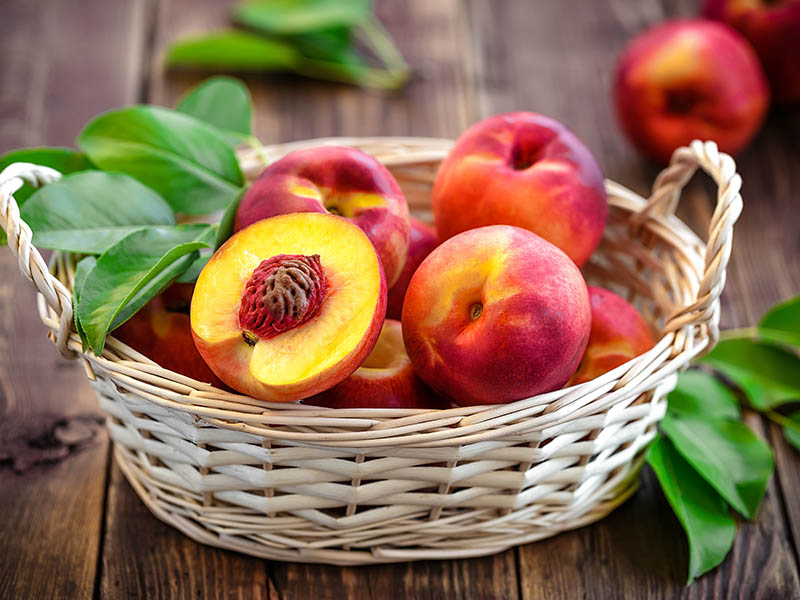
Nectarines have a peach-like shape with shinier skin. The fruit skin is smooth and varies from orange to red when ripe. Inside, the flesh is yellow with a soft-yet-firm texture and contains a large single seed in the core.
You can tell if nectarines are completely ripe by their floral fragrance and softer texture. Also, tasting their flesh is a way to know. When mature, nectarines taste sweet and tart with a hint of honey-like flavor. Meanwhile, the unripe fruit will taste sour, added with an acrid flavor.
With a tasty flavor, there are many delectable juicing recipes you can utilize this fruit for. You can also use its flesh to make cakes, pies, and tarts. To peel nectarines with ease, you can let the fruit sit in boiling water for fifteen to thirty seconds for the skin to loosen.
What are the differences between nectarines and peaches? Check out this scientific explanation!
O To Z Tasty Fruits Have A Beautiful Orange Sunset Color
Are you satisfied with the first half of the list? If not, keep reading, as the latter half of the list will feature the names of many strange and less common orange fruits. So let’s continuously count the alphabet; one, two, three, go!
8. Oranges

As their name suggests, oranges are citrus fruits with a distinctive orange color. The fruit has a round shape with a leathery peel. The fruit interior is juicy and pulpy, usually divided into ten segments. When ripe, oranges taste sweet and a little tart with a citrusy afternote.
Consuming oranges every day will bring you numerous health benefits. In particular, oranges contain lots of vitamin C. One orange will provide you 116.2% vitamin C of the daily value (DV), helping boost your immunity and prevent cancer conditions.
Besides eating the fruit raw or turning it into outstanding orange desserts, you can also utilize its peels for beauty care. Orange peels are rich in minerals like calcium, potassium, and magnesium, helping glow your skin and contribute to your future flawless skin.
9. Orange Bell Pepper
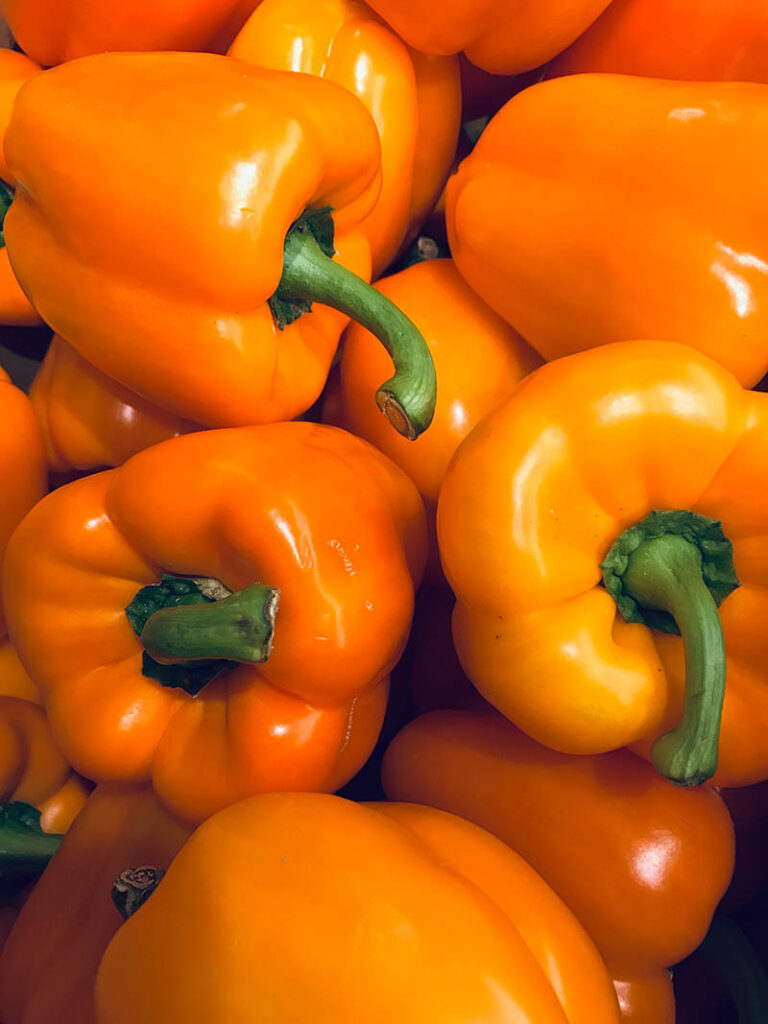
Compared to green bell pepper, the orange variety has a sweeter taste, thanks to its ripeness. When you bite a corner of orange bell pepper, you will feel a crispy texture with a tangy afternote lingering on your tongue. Noticeably, there is no spicy and bitter flavor in this fruit.
Like other bright-colored fruits, orange bell pepper does contain high antioxidant content, namely carotenoids and lutein. These nutrients will help you fight heart disease and cancer and improve your eye health. Thus, consuming fruit daily will enhance your overall health.
In particular, you can use orange bell pepper in any recipe. You can use it to make salad and pasta or cook it with other vegetables and meat. Orange bell pepper will fit with plates of steaks, seafood, and steaks if you want more specific.
How does a freshly picked orange bell pepper taste? Here is the answer.
10. Orange Cherry Tomatoes
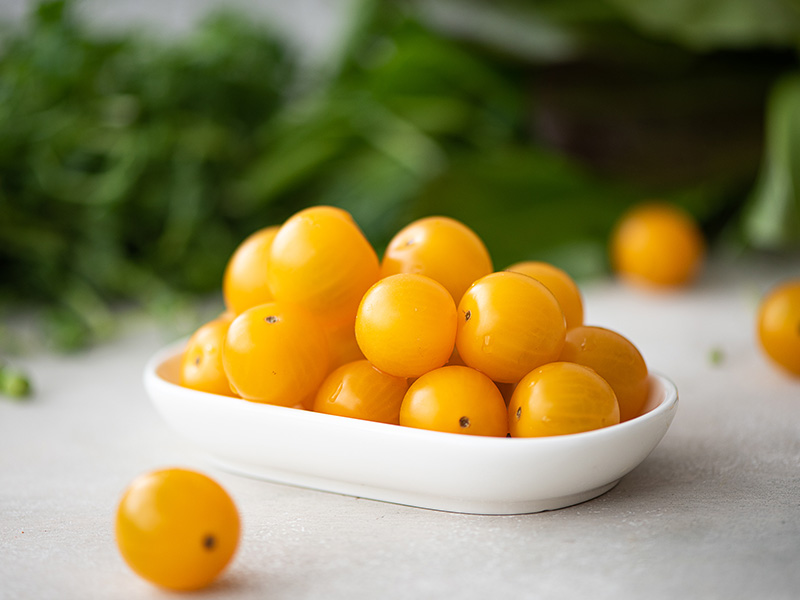
Orange cherry tomatoes have a round or oval form with a cherry-like size. In particular, the fruit earns its name from its beautiful skin color, a vibrant orange. All combined, create a candy-like appearance, which may excite your little kids.
Unlike regular red tomatoes, orange cherry tomatoes are not well-known fruits. However, compared to others, they have a sweeter taste. When you have a tiny orange cherry tomato in your mouth, there is a candy-like feeling, and sweet and fruity flavor all at once.
With its sweetness, you can use cherry tomatoes in recipes that call for regular tomatoes. For example, put them fresh in salads or cook them for main dishes like pasta. Tomatoes and cheese will also be a perfect combination for your summer snack.
11. Orange Kabocha Squash
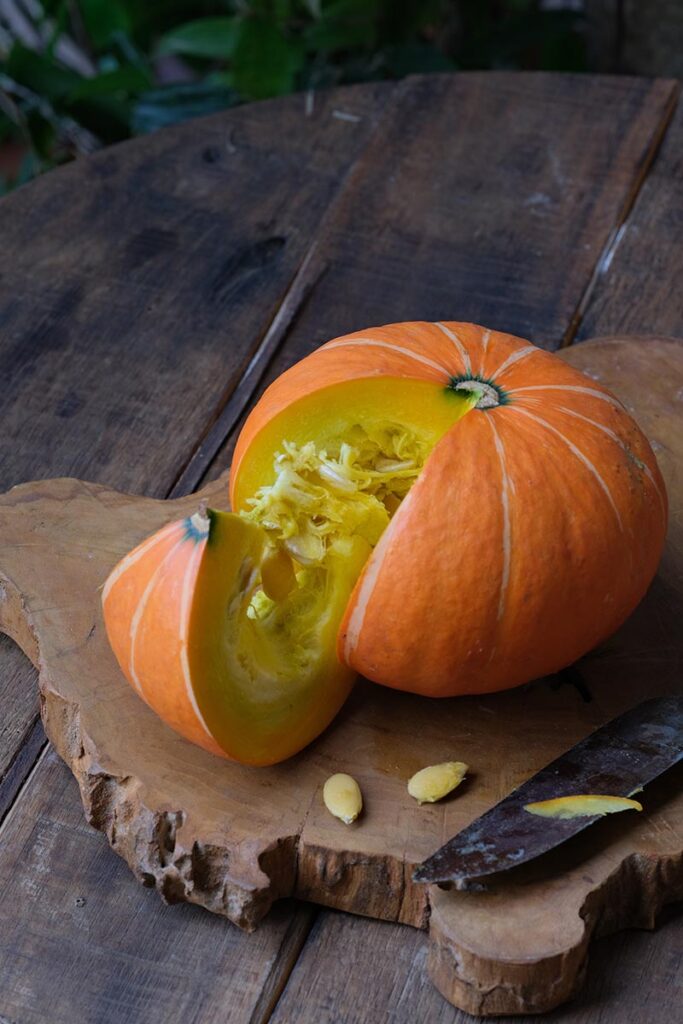
Orange kabocha squash has a pumpkin-like shape with vibrant orange skin. Like other squash, the fruit skin is firm and hard to peel. On the surface, many uneven stripes run vertically from top to bottom with white or light green color. Inside, the flesh is orange and has a pumpkin-like texture.
By consuming orange kabocha squash, you can enjoy the supply of carotenoids and vitamin A, helping combat cancer and enhance your eye health. Besides, this fruit is also an excellent source of folate, helping prevent infant defects when used in early pregnancy.
There are plenty of ways to prepare orange kabocha squash worldwide. While in Japan, people use kabocha to fry with other vegetables making tempura, Koreans use it to make Hobakjuk, a famous squash soup in Korea. Besides, people also use kabocha to thicken the curry dish.
Let’s learn four easy ways to cut orange kabocha squash!
12. Papayas
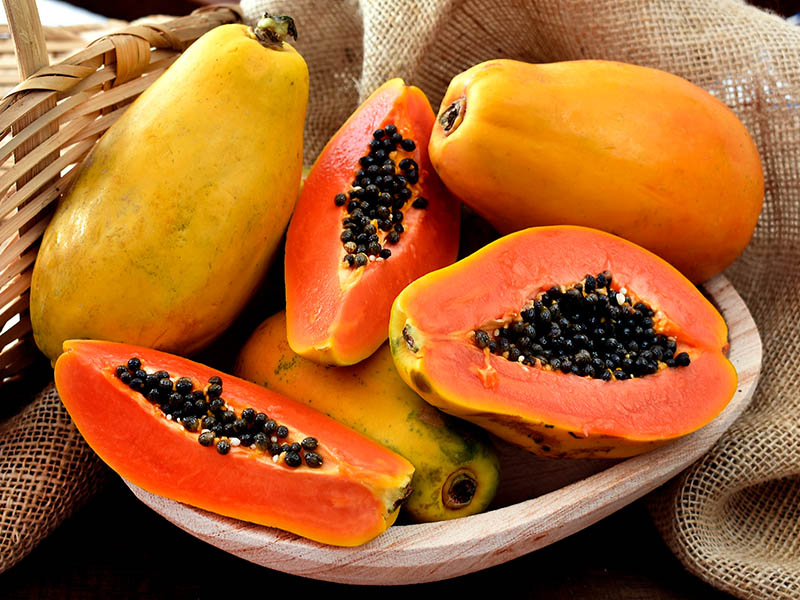
Papaya will smell completely different based on its ripeness. When unripe, papaya is tasteless and has an additional acrid afternote. Meanwhile, when ripe, it tastes super sweet with a hint of floral flavor and pleasant buttery texture.
Thus, people will utilize each ripe state of papaya for different cooking purposes. While they use unripe papaya to make the salad and cook soup, people will use the ripe one for smoothies, baking cakes, and fruit pizzas.
In addition, papayas also bring many health benefits to humans. They contain loads of antioxidants like carotenoids, helping combat free radicals and reduce diseases. Besides, the lycopene and vitamin C in papayas also help promote your heart health.
13. Peaches
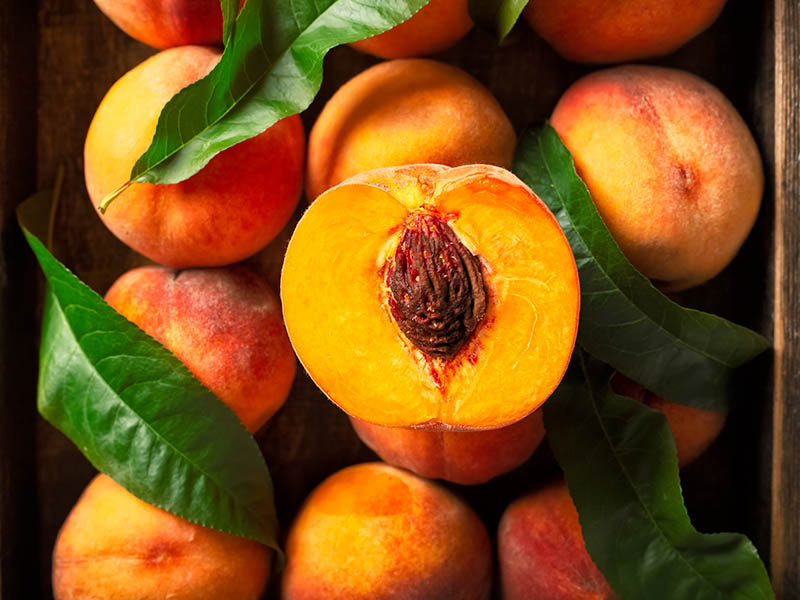
Peaches are rounded fruits with thin skin. The outer skin has a furry texture and pinky-orange color, while the flesh is juicy with vibrant yellow.
When mature, the fruit will be softer and sweeter with a floral afternote stuck in your mouth. Thanks to their excellent flavor, peaches are among the most popular kinds of canned fruit.
Not only tasty, but peaches also provide many nutrients to your body. They are full of antioxidants, helping you reduce the risk of aging and cancer disease. Besides, peaches also contain histamines, helping relieve the allergy you currently experience.
Fun fact, people also use the word “peach” to express their gratitude or admiration. If someone calls you “a perfect peach”, they find you attractive or pleasing.
Try this summer classic peach dish – peach cobbler!
14. Persimmons
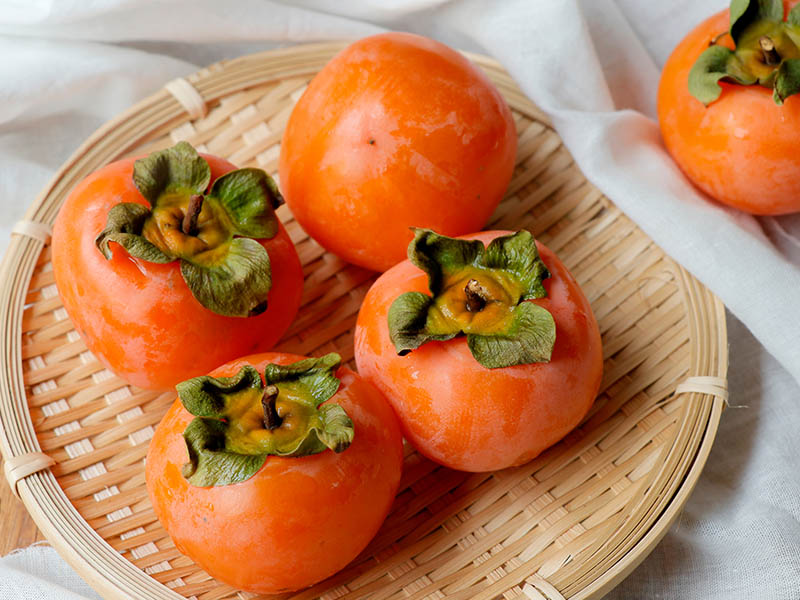
Persimmons have a unique taste that is hard to find in other fruits. The fruit tastes sweet and mild with an astringent undertone. Besides, the lingering flavor has a cinnamon hint and a sweet, honey-like flavor.
Having persimmons will help you decrease the risk of heart diseases, thanks to their tannic acid and gallic acid sources. Also, persimmons are fiber-rich, helping fight constipation and promote your overall digestive health.
However, persimmons also have some side effects you should keep in mind. In particular, some people might be allergic to the fruit, resulting in nausea or an upset stomach. Consuming too many persimmons might lead to gastrointestinal problems.
15. Physalis
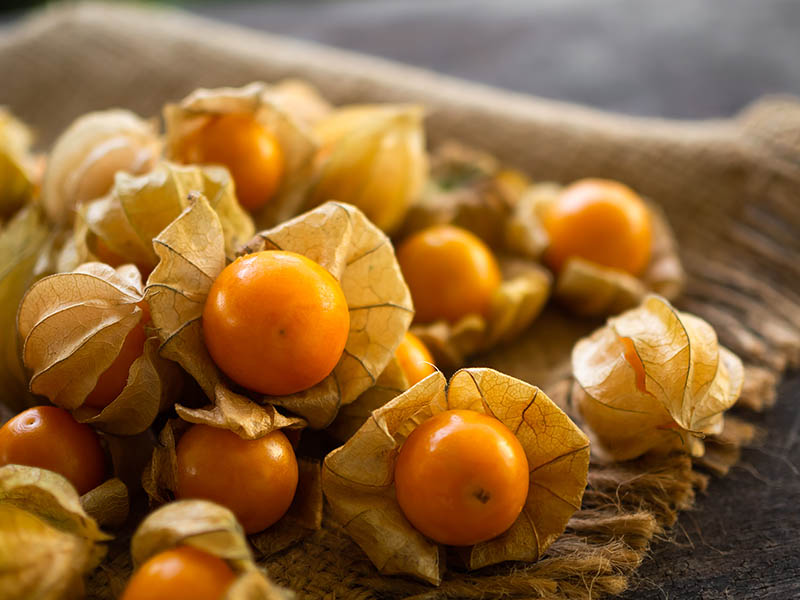
Physalis, also known as the goldenberry, is a small berry with a round shape. The fruit is vibrant orange and covered by a paper-like husk on the outside, creating a catching look like a lantern. However, when eating fruit, you need to get rid of that husk since it is inedible.
By taking a bite of physalis, you will feel the balanced sweetness and sourness of it in your mouth with an aromatic afternote. In addition, the juicy and tender texture of the fruit flesh with several tiny edible seeds will make your experience more enjoyable.
Physalis has been a widely-known medicine in many countries. While it is used to treat kidney stones and gout disorders in Europe, people use physalis leaves in South Africa to cure inflammations.
16. Pumpkin

Thanks to its high nutrient content, pumpkin is one of the superfoods loved by many people. It contains multiple vitamins, such as vitamin A and E, helping protect your skin health and block sunburn. Besides, carotenoids in pumpkins also promote immunity and prevent cancer risk.
Due to its creamy texture, people usually use pumpkins to make soups and curries. Moreover, you can also turn your pumpkin into different desserts, such as pies and cakes. It will have an excellent texture and taste pleasant to your family and guests.
So, is there anybody who should not eat it? People who are allergic to pumpkins or are taking medications with substances such as lithium should not eat pumpkins. It will make your allergies worse and cause serious side effects with the medicine you are taking.
17. Tangerines
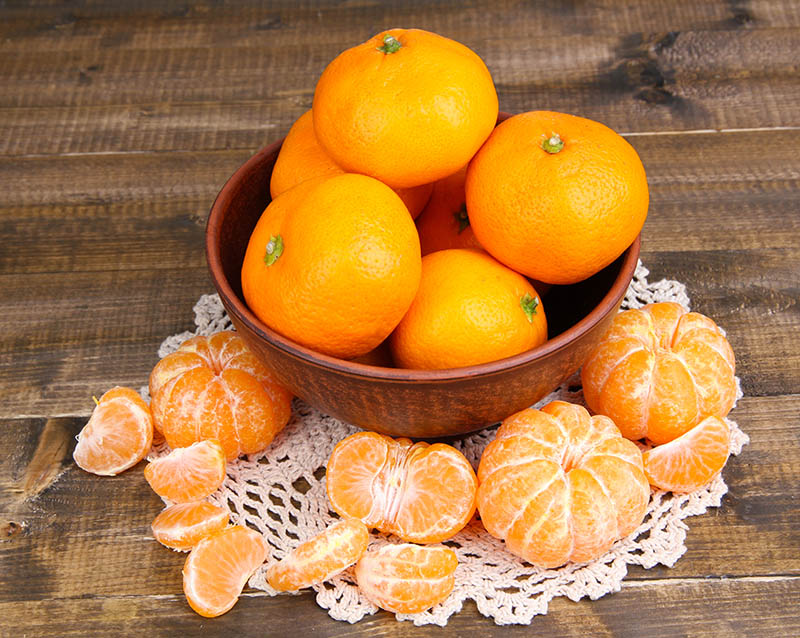
Compared to oranges, tangerines have a more potent and pleasant flavor. They taste sweet and a little tart with a hint of citrus. Noticeably, the bitter aftertaste is shorter than in oranges, making sweet lovers like me prefer it more.
Besides eating tangerines raw, you can use its flavor for any favorite dish. You can utilize its segments for baked cakes or use its juice to replace vinegar in your salad dressings. Furthermore, tangerine peels are a top-notch ingredient for your soup and meat.
Indeed, consuming tangerines will change your whole body. On the outside, tangerines help protect your skin from aging and wrinkle formation, thanks to their antioxidants. Inside, the vitamin C and potassium in tangerines will help improve your muscle system and overall health.
Do you want to know when your tangerines are ripe? Dig in!
Orange Fruits Promote Your Health To Next Level
Well done! You have gone through a list of orange fruits and gained tons of beneficial information about them. And I know you have noted some for your family tomorrow’s meals, don’t you? Let me know the answer in the comment section below.
Besides, if you believe this post is informative and helpful, please feel comfortable giving me a like and a share. I would appreciate it. Thank you and farewell, mate!


Linda Dean
Expertise
Culinary Arts, Food Journalism, Global Cuisine, Exploration, Recipe Development, Cultural Food Studies, Culinary Travel and Storytelling
Education
Culinary Institute of America, Hyde Park, NY
Program: Associate in Culinary Arts
Focus: Developed a comprehensive understanding of global cuisines and essential cooking techniques. Engaged in intensive hands-on practice in both kitchens and real-world settings, guided by expert chefs. This program emphasized the application of culinary skills in professional environments, preparing students for a variety of roles in the culinary industry.
City, University of London, London, UK
Program: BA Journalism
Focus: Gained expertise in media studies with a strong foundation in reporting, editing, and communicating. While the program focuses broadly on journalism, the skills acquired apply to food journalism, including the ability to analyze and report on food culture and culinary trends effectively.
Linda Dean is an experienced chef and food writer who loves exploring flavors from around the world. Trained at the Culinary Institute of America, Linda has spent over ten years mastering the art of making dishes that truly represent different cultures. She also studied journalism at City, University of London, which helps her write engaging stories about these foods.
On heythattastesgood.com, Linda shares recipes that bring the world’s kitchens to her readers. She focuses on authentic tastes and the stories behind them, making it easy for anyone to try international cuisine at home.